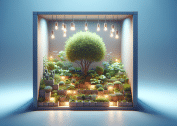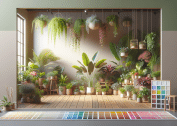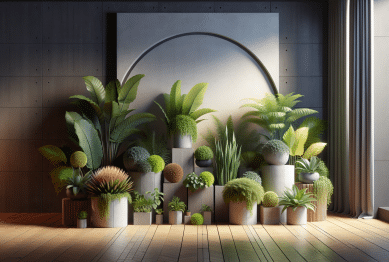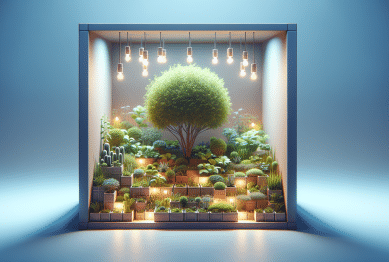Explore essential tips for creating a thriving indoor plant oasis. This practical guide reveals how lighting, watering, soil choice, plant selection, and maintenance routines turn any room into a beautiful, green sanctuary. Discover what helps houseplants flourish and boost your home’s natural beauty.
Choosing the Right Indoor Plants for Your Space
Selecting houseplants suited for your environment is key to their health. Consider available sunlight, humidity levels, and temperature in each room before shopping. For low-light spaces, snake plants and pothos adapt well, while sun-filled areas may support vibrant succulents and flowering varieties. Each plant comes with unique requirements, so reading care tags and researching options brings clarity to your decision-making process.
It often surprises new indoor gardeners how much location impacts plant survival. East-facing windows with gentle morning light are ideal for ferns, while bright south windows can accommodate jade plants or cacti. Grouping moisture-loving species together helps maintain humidity and keeps leaves lush. If you’re uncertain, start with resilient varieties. Many novices have success with ZZ plants and spider plants, which tolerate occasional neglect yet reward with robust growth.
Plant size also matters. Large palms may add drama to living rooms but overwhelm compact apartments. Consider mature dimensions and growth speed before purchasing. Think about your intended aesthetic—whether you seek a dramatic focal point or subtle greenery sprinkled throughout the home. Mindful matching of plants to space increases the likelihood that your living decor thrives without stress or crowding.
Understanding the Importance of Lighting for Houseplants
Proper lighting is foundational to healthy indoor gardening. Different species require varying light intensities, from bright and direct to gentle and indirect. A common mistake involves misjudging sunlight levels, leading to scorched foliage or stunted growth. Place plants within several feet of a light source and experiment with positioning to match their preferences. If your space lacks natural light, many indoor gardeners turn to LED grow lights to fill the gap, promoting robust photosynthesis year-round.
Light duration matters almost as much as intensity. Most common houseplants need at least 6 to 8 hours of light daily. South and southwest windows can deliver abundant natural rays, while filtered curtains prevent sensitive leaves from burning. Rotate plants every couple of weeks to ensure all sides get exposure, as this helps produce even, lush growth. If your windows face north or are shaded, artificial lighting systems offer an effective supplement, supporting even challenging tropical species.
Symptoms like leggy stems, yellow leaves, or leaf drop often signal lighting problems. Observing plant behavior and adjusting placement can prevent long-term issues. Strategic use of mirrors or white walls also helps to reflect and amplify available light, maximizing each plant’s exposure. With attention to lighting needs, anyone can encourage greener, healthier results indoors.
Watering Techniques That Keep Houseplants Happy
Watering routines make or break houseplant success. Overwatering is the most common reason for indoor plant decline, causing root rot and yellowing foliage. The general rule: check soil moisture before watering. Stick a finger into the soil—if the top inch feels dry, it’s usually time to add water. During winter months, plants require less frequent watering, while summer heat may mean increased hydration. Consistency supports vibrant growth.
Water quality also affects plant health. Tap water, especially with high chlorine or mineral content, might stress delicate tropicals or ferns. Allow water to sit overnight for chlorine to dissipate, or use filtered water. When possible, water at the soil surface—avoid soaking leaves, which can encourage pests or fungal problems. Draining excess water after each session ensures roots don’t become waterlogged, discouraging disease and decay.
Sections with higher humidity, such as kitchens or bathrooms, may demand less frequent watering than living rooms or offices. Using self-watering pots or incorporating a drip tray helps regulate moisture. Observing leaf condition gives vital clues—wilting can mean over- or under-watering, so track changes and refine your approach. As each species varies, tailor your method for best results, supporting consistently thriving greenery.
The Role of Soil and Fertilizer in Indoor Plant Growth
Soil is the foundation of a strong indoor garden. Using the right type is critical—standard garden soil compacts easily indoors and holds excess moisture. Instead, choose a well-aerated potting mix designed for houseplants. These mixes balance moisture retention with drainage, ensuring roots get oxygen and reduce disease risk. Consider specialized blends for succulents, orchids, or ferns to give each plant group ideal support.
Fertilizing helps replenish soil nutrients that diminish over time. Most houseplants benefit from monthly feeding with a balanced, water-soluble fertilizer during their spring and summer growth phases. Fertilizer labels guide safe dosages; over-application can burn roots or encourage salt buildup. For sensitive varieties, dilute feedings or opt for organic amendments, ensuring slow, gentle nutrient delivery over several weeks.
Regular repotting—every 1 to 2 years—refreshes soil structure and supplies new nutrients, preventing compaction and crowded roots. Carefully select containers with drainage holes and avoid using oversized pots, which can foster soggy soil conditions. Attending to the soil and fertilization needs supports healthy blooms and foliage, enhancing the vitality and longevity of your indoor oasis.
Easy Maintenance Routines for Healthy Indoor Plants
Consistent maintenance ensures your indoor garden stays resilient and vibrant. Set aside weekly time to inspect leaves for dust, pests, or early signs of disease. Gently wipe dust from foliage with a damp cloth to help plants breathe and absorb light better. Quick pruning of yellowed or dead material improves circulation and redirects energy into thriving new growth, making maintenance a rewarding process rather than a chore.
Houseplant pests such as spider mites, mealybugs, or aphids occasionally trouble indoor environments. Identifying issues early makes control easier and reduces the need for harsh solutions. Non-toxic methods like insecticidal soap or a dilute neem oil spray can keep pests in check while remaining safe for pets and children. Cultivating good air circulation and avoiding overcrowding also limit pest outbreaks, promoting a balanced indoor ecosystem.
Tracking your successes and setbacks is invaluable. Maintain a simple plant journal or digital tracking app to log watering, fertilizing, and pest management. Celebrate small milestones, such as new leaves or blooms, as positive reinforcement. Over time, fine-tuning your routines based on experience ensures that your houseplants flourish with consistency and care. This attention makes any home feel more welcoming and alive.
Design Inspiration: Arranging Plants for Visual Impact
Arranging houseplants thoughtfully transforms living spaces. Grouping plants of varying heights and leaf textures creates depth and movement, encouraging natural interest. Place tall plants at the back and trailing vines at the edge of shelves for a cascading effect. Complement greenery with decorative pots and stands that reflect your style, boosting both mood and visual appeal of any room.
Experimenting with placement changes the feel of a space dramatically. Tall plants like dracaena frame entryways, while hanging planters add life without consuming floor space. Portable carts or rolling trays allow easy reconfiguration, adapting greenery as seasons—and sunlight angles—shift. Consider color coordination by mixing shades of green with vivid foliage plants for playful accents or monochrome tranquility.
Plants can also serve as creative room dividers, defining open layouts into cozy nooks. Living walls introduce lush, vertical elements that support both aesthetics and air quality. With a little creativity, key design elements like natural light, symmetry, and negative space are leveraged to maximize plant impact. This artistic approach personalizes interiors and highlights a unique home aesthetic.
References
1. University of Maryland Extension. (n.d.). Growing houseplants indoors. Retrieved from https://extension.umd.edu/resource/growing-houseplants-indoors
2. Royal Horticultural Society. (n.d.). Managing indoor plants. Retrieved from https://www.rhs.org.uk/plants/types/houseplants
3. American Society for Horticultural Science. (n.d.). Houseplant care recommendations. Retrieved from https://ashs.org/page/houseplants
4. PennState Extension. (n.d.). Houseplants: Watering and fertilizer requirements. Retrieved from https://extension.psu.edu/houseplants-watering-and-fertilizer-requirements
5. University of Minnesota Extension. (n.d.). Common houseplant issues. Retrieved from https://extension.umn.edu/houseplants/common-houseplant-insects
6. Gardening Know How. (n.d.). Light requirements for indoor plants. Retrieved from https://www.gardeningknowhow.com/houseplants/hpgen/houseplant-light-requirements.htm









